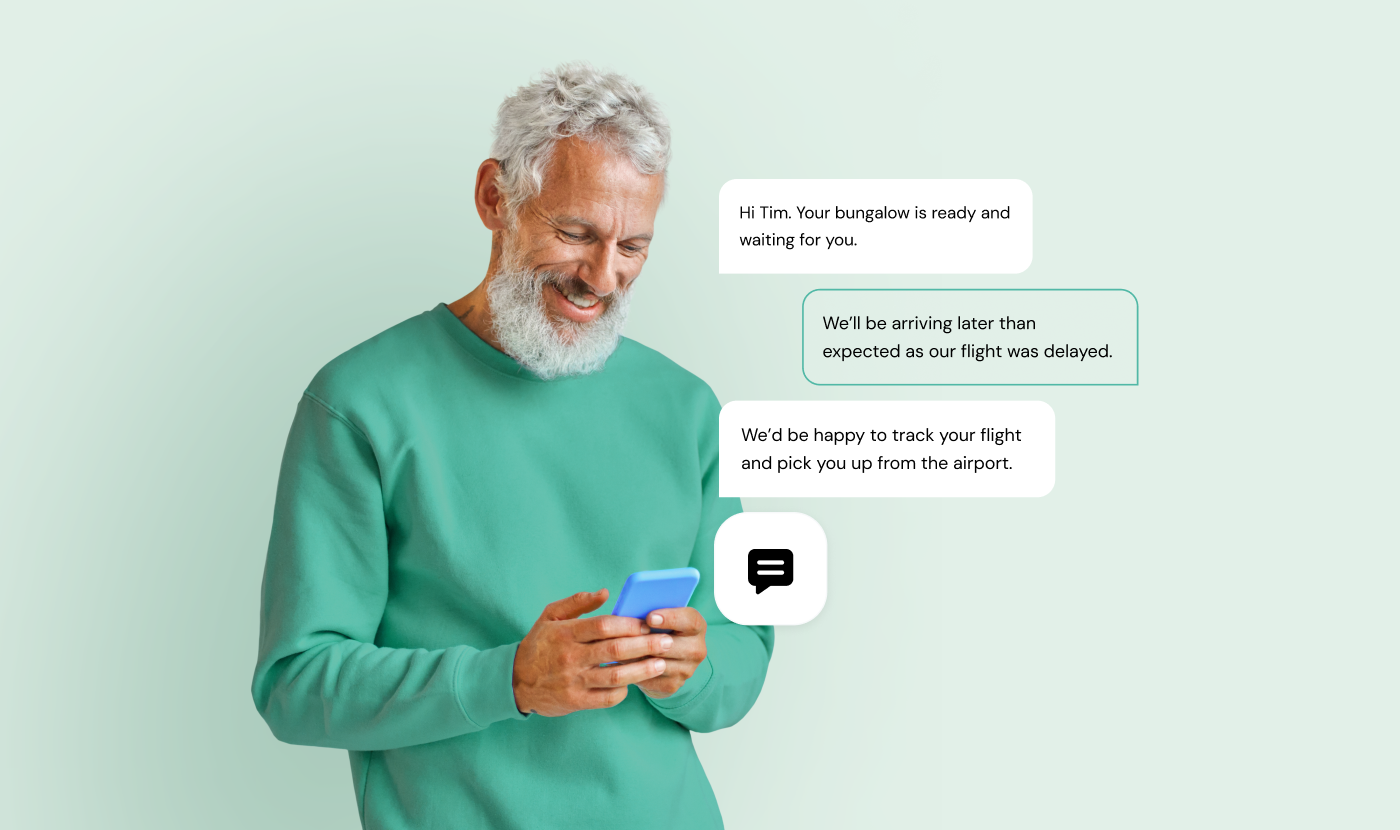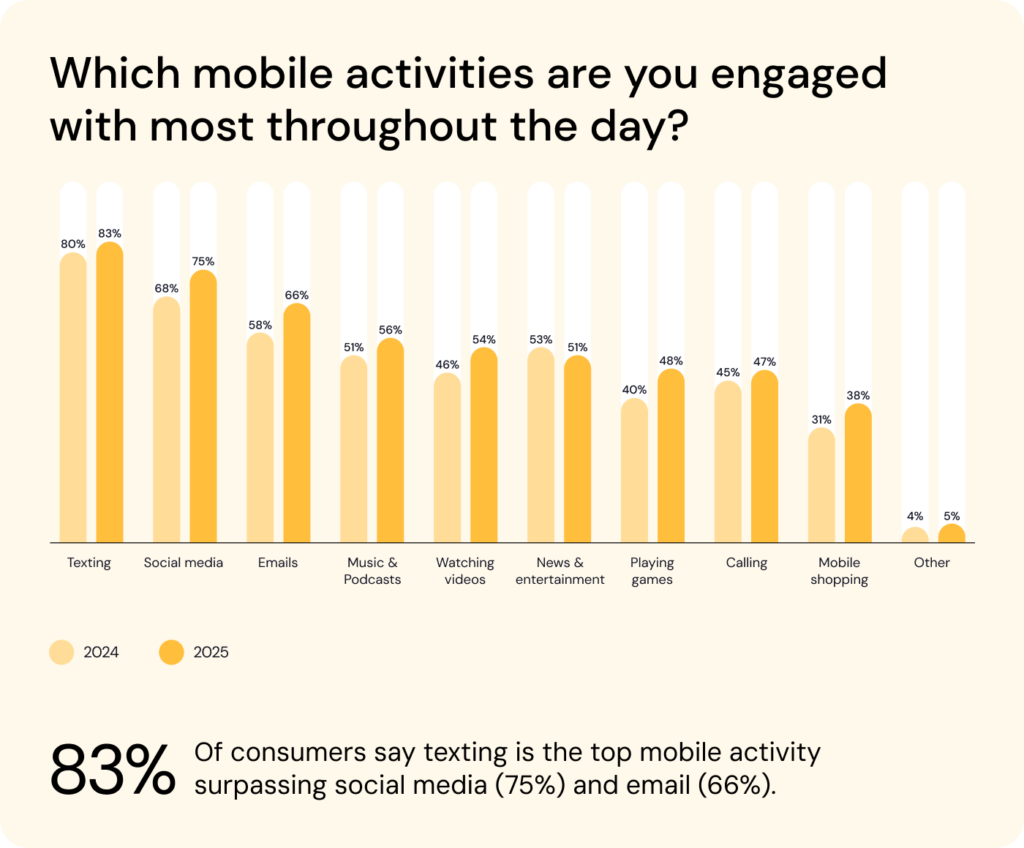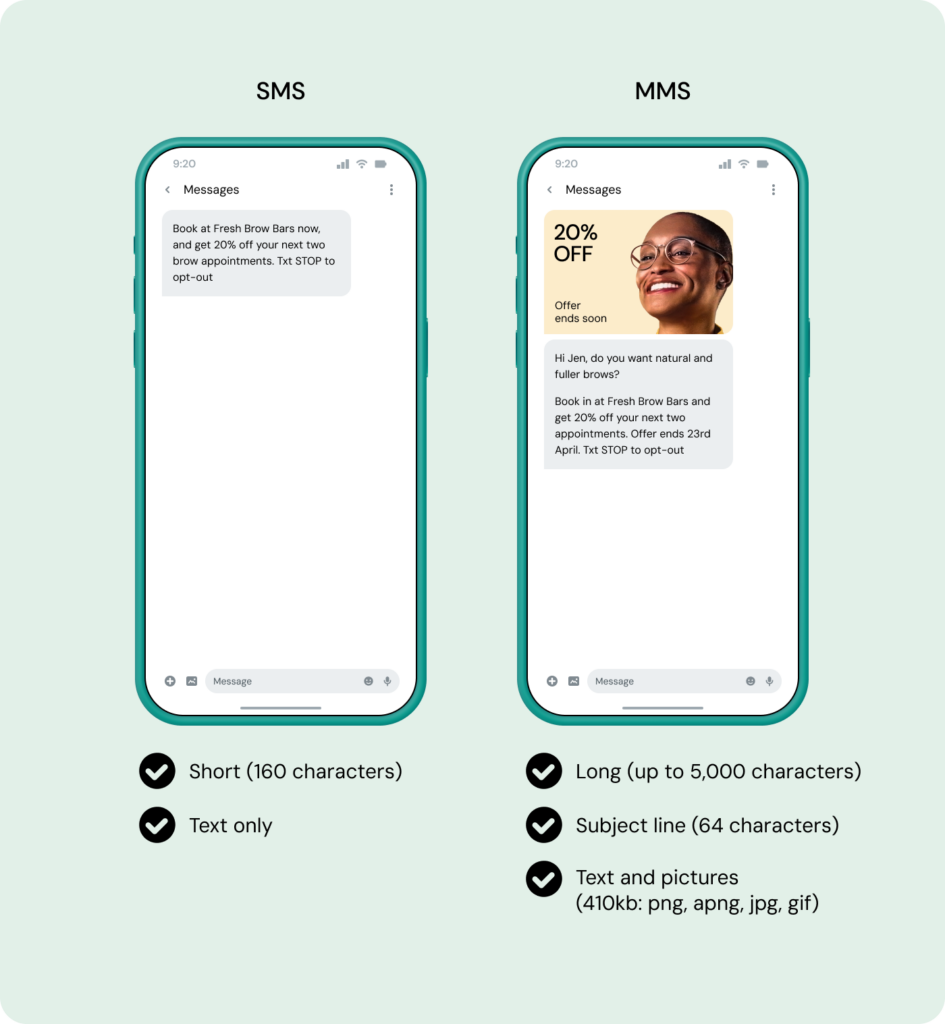Insights
The ultimate guide to SMS

Insights

SMS, or Short Messaging Service, is a service that sends text-only messages of up to 160 characters between two mobile devices. While SMS and text messaging are often used interchangeably, text messaging is an umbrella term that includes SMS, MMS, and RCS messaging.
An estimated 27 billion SMS messages are sent every day. That’s roughly 72 messages a day per person.

Did you know?
SMS can only contain alphabetic or numeric characters, limited to 160 characters.
Fun fact:
The first SMS was sent in 1992.
Texting has become a global phenomenon, with volume and frequency rising every year. In 2025, 84% of consumers opted in to receive texts from businesses – indicating a 6% growth in consumer opt-ins from last year.

Many customers turn to SMS because it helps them make better connections while saving time and money.
But since text messaging is how people frequently communicate with friends and family, some businesses assume that business texting is intrusive. While it’s true that texting too frequently is the fastest way to lose subscribers, when businesses apply balance and personalization to their texting strategy, consumers are often more engaged.
In fact, many consumers now choose texting over email and phone calls for customer service issues, and 71% of consumers want the ability to text a business back.
Boost your marketing, sales, and e-commerce capabilities by communicating with prospects and customers who have opted in to receive SMS. Send promotions and offers, confirm orders, provide real-time delivery updates, ask for feedback, and request reviews to amplify your existing communication channels.
Promotional
Order notifications
Lead conversion
Shipping updates
Customer feedback
Teams often send automated email notifications to prospects, customers, and partners for frequent communications and tasks like scheduling appointments, reminders, and confirmations. The same can be done with SMS with better results (texts response rates are 8x that of email).
Leverage SMS for:
Operations and logistics SMS message examples:
Thank you for your order of {shippingitem}, it is on the way. You can track your order here {trackinglink}. Thanks, Rich Hay – Photo Warehouse. To unsubscribe text STOP
Hi {firstname}, Your {purchaseitem}, is ready. Here are directions on where to park for contactless pickup. Text HERE when you arrive. Rich Hay – Photo Warehouse. To unsubscribe text STOP
Hi {firstname}, Thank you for your order of {shippingitem}. Please respond Y to confirm that this is the item you want to purchase, and you would like us to proceed with shipping. Thank you! Rich Hay – Photo Warehouse. To unsubscribe text STOP
When customers experience an issue with your product or service, they want it solved as quickly as possible. Waiting in an endless phone queue or going back and forth via emails to troubleshoot issues can be frustrating and time-consuming.
In addition, text-based communication resolves problems far faster than email, reducing queue lengths and increasing customer satisfaction and retention.
Use SMS for:
Customer support SMS message examples:
Hi {firstname}, Did we resolve your support issue # {SupportCase} satisfactorily? If so, please respond with Y, and if not, how can we help? Bob Hays – Acme Customer Support
Hi {firstname}, Thank you for contacting our support team! Please let us know how we did – respond with 1 (Not helpful) to 10 (Awesome!) Bob Hays – Acme Customer Support To unsubscribe text STOP
Hi {firstname}, Your support ticket has been updated to a status of {status}. We will keep you notified as your ticket progresses. Bob Hays – Acme Customer Support To unsubscribe text STOP
Your business may need to schedule appointments for on-site estimates, field service and maintenance visits, or to coordinate deliveries and curbside pickups. With text messaging, you can include links for people to reply and confirm quickly and conveniently.
Appointment confirmation and reminder SMS message examples:
Hi {firstname}, We apologize, but due to unforeseen equipment delays, we need to reschedule our install to 3:00 PM tomorrow. If that works, please respond with Y. Bob, Acme Corp. To unsubscribe text STOP
Hi {firstname}, Our service technician, {STfullnamename} will arrive at {BusinessAddress} at 10:00 AM today. Please text Y to confirm that you will be on-site and ready to accept the delivery. Rich Hay – Diesel Repair To unsubscribe text STOP
Hi {firstname}, I will arrive at 2:00 PM today at {CustomerAddress} for a pool repair estimate. Text Y to confirm or text me date/time if you need to reschedule. Rich Hay – Acme Pool To unsubscribe text STOP
Combine SMS with your other communication channels for the best results.
The first step in adding SMS to your toolkit is to analyze your communications and processes to determine where text messaging can help the most.
This checklist can get you started:
Answers to these questions can lead you in the right direction.
We’ve analyzed millions of business text messages, and these are the key elements of a winning SMS:
1. Personalization: Make the SMS relevant. Include your business name and the customer’s name if possible.
Top tip: We integrate with 85+ CRM, ERP, and Marketing Automation systems to help make personalization easy.
2. Valuable message: Your SMS needs to be worth the recipient’s time. Include all important details in the message.
3. Opt-out option: Always provide an option for subscribers to opt out.
4. Call to action: Give customers a clear next step — such as a link to their cart, an appointment confirmation, or a survey.
5. Be succinct: Keep your SMS short and simple to grab attention quickly.
Example:
Hey Terry, Thanks for your order with Pets R US! Your order has shipped. Track your shipment progress here: [URL] STOP to opt out
For your message to be successful, it should be as short as possible while still providing all necessary information. Ideally, messages should be 160 characters or fewer. SMS messages that exceed 160 characters will often be split into two separate messages.
Promotional marketing messages require customers to opt in before you send them a text.
Include your business name at the beginning of messages to new customers. Prioritize critical information so customers immediately understand the purpose of the message.
If necessary, your message should attract attention.
Unless your message is purely an alert, always include a call to action (CTA). Confirm an appointment, complete a purchase, or finish a survey – these messages will only be successful if you help your customer to complete these actions by providing a URL or phone number.
After sending your message, analyze its performance to improve future communications.
Send the text that’s right for your message.

Comparison table
| Feature | SMS | MMS |
| Character Limit | Short (160 characters) | Long (up to 5,000 characters) |
| Subject Line | Not available | Available (64 characters) |
| Media Support | Text only | Text + Images (410kb: PNG, APNG, JPG, GIF) |
Texting features to look for with your business partner:
Make sure that your SMS messages are compliant by regularly reviewing the latest legal requirements and regulations.
Pro tip: Mention your business’s name in the first few messages you send so people know who the messages are coming from.
Do:
Don’t:
Note: These tips and tricks are intended as general information only, not legal advice. There are many laws, regulations, and best practices applicable to SMS compliance, and you are responsible for ensuring compliance.
With 82% of consumers checking their text messages within 5 minutes of receiving them, if it’s not already on your roadmap to increase revenue, improve customer satisfaction, and reduce costs – it should be.
But don’t take our word for it; here’s a recent quote from a customer using our texting solutions:
“Sinch literally covers all of our markets. In the end, the simplicity that Sinch offers provides what we need at the highest quality. That’s why it has been a great partnership.”